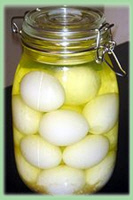
How to Can Pickled Eggs the Safe Way

|
There are 2 Pickled Egg Recipes below: 1) Recipe to make just 1 Quart (12 eggs) and requires refrigeration. 2) Recipe to CAN 7 quarts (84 eggs) - This method allows unrefrigerated storage until the jar is opened. We have used this recipe to can pickled eggs for decades. We have routinely stored our canned jars of pickled eggs for 6 months or more in our basement in a dark corner on shelves. Our basement is never warmer than 60 degrees and we have never had a problem with our canned pickled eggs. However, please read the note of caution below before proceding to can pickled eggs in your home. Note of caution: There is a potential risk of botulism. Here are the facts surrounding home canning pickled eggs: The NCHFP (The National Center for Home Food Preperation) states that home canned pickled eggs should always be refrigerated at 39 degrees F (3.8 C) or lower. The reason for this is that botulism can grow in the following conditions:
The following points are the most critical to ensure safety from botulism:
If you do choose to keep your canned eggs un-refrigerated, you should keep them as cool as possible and out of direct sunlight. The following recipes assume you are experienced with canning and all the safety requirements that go along with canning, such as: Keeping everything sterile, washing your hands, rinsing the eggs and pre-heating them to kill any surface spores before packing in the jar etc. Having dispensed with the litigical requirements, onto a mouth watering treat: Click here for Egg Peeling Tricks Recipe 1: (1 Quart method that requires refrigeration) Hard Boiled Eggs First, hard boil around 14 medium to large sized eggs. Approximately 12 eggs will fit in one quart jar. But during the peeling process, you may ruin a couple of eggs, so it is best to boil a few extra. Peel these eggs and set them aside. Creating the Brine: Mix the following in a pot, cover and bring to a boil: (You can use the microwave) 2 Cups Vinegar (5% acidity) 2 Tablespoons Canning Salt (non-iodized) 1/2 Teaspoon Dill Seed 1 Clove Garlic Sliced into thin slices 1 Jalepeno sliced into thin slices (Or try using a Habanero instead) Once a boil has been reached, let it boil for 3 - 4 minutes and remove from heat. Packing: For a fuller flavor, strain the Jalepeno and Garlic from the brine and place in the bottom of your 1 quart jar. Peel your eggs and pack into the 1 quart jar on top of the Jalepeno and Garlic slices. Stir the brine well to make sure the salt is well suspended, then pour the Hot Brine over the eggs into the jar until about 1/2 inch from top. Place lid on jar tightly and shake. Refrigerate for 1 to 10 days before eating. (bet you can't wait the full 10 days). It does help to shake the jar everyday to keep the solution from settling to the bottom. Recipe 2: ( 7 Quart Canning method ) Allows unrefrigerated storage in a cool, dark basement. Canning Method: If you are making many quarts of pickled eggs and would like to CAN them, such that they do not require refrigeration until opened, then follow these instructions: - Use 1 Quart Canning Jars, Rings and Self-Sealing Lids (Like Mason Jars) - Follow the manufacturers instructions for Lid Preparation (some require boiling the lids) - Sterilize Jars, Rings and Lids Preparation: Boil and peel 8 Dozen Eggs (even though you are canning 7 dozen, sometimes you can fit 13 eggs in a jar or some eggs will be damaged during boiling or peeling process) Never use an egg that is damaged. The surface of the egg should be flawless to prevent Clostridium botulinum from entering the egg. If you use the ice trick to peel the eggs, you will want to re-heat the peeled eggs before packing them in jars. Place the peeled eggs back into a pot of water and raise the temperature of the water to 200 degrees to kill any bacterium on the surface of the eggs. Canning Pickled Eggs Safely Place your canning pot on the stove with 3 to 4 inches of water in the bottom, place your jars in the canning pot and preheat them. In another pot, bring about a gallon of water to 200 degrees F (this will be used to cover the jars later) Create the Brine: In a Large Pot, Combine and boil the following: 15 Cups vinegar (5% acidity) 3/4 cup canning salt (non-iodized) 3 1/2 teaspoons dill seed or 7 sprigs of dill weed 5 to 7 Cloves garlic sliced thin 5 to 7 Jalepenos sliced thin (Or try using Habaneros instead) Stir and bring to 200 degrees F. note: you may add or change the spices to suit your taste, but do not change the vinegar or salt. Many people enjoy adding red beet wedges to the jar, to give the eggs a reddish color. This is common in different parts of the USA. Feel free to try this. It doesn't add any flavor to the eggs, but makes the presentation of the jar more festive. Packing and Canning the eggs:
As an added list of instructions, I refer you to an expert, Dr Snyder of HITM. His instructions are found at: Pickled Eggs HACCP But do not follow his ingredients, use the ingredients found here, if you want the flavor of our age old recipe. Dr. Snyder points out the proper technique for canning pickled eggs which may be stored in a basement for 6 months.  |
|